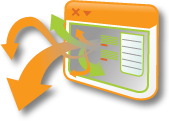
While some of the initial fervor over Google Wave has died down, desire to obtain one of the elusive invites remains just this side of Charlie Bucket’s desire for one of Wonka’s Golden Tickets. For those who have been lucky enough to receive an invite (like myself), an initial period of confusion is soon replaced by other periods of confusion. It’s not that the platform doesn’t do what it’s supposed to (although, I’ve crashed it a few times), it’s that it’s not immediately apparent what the value of the platform could be.
The platform itself looks like a mashup of email, chat, and file/function attachments. Robots can be added in to provide additional functionality (I found the Wikipedia and Wolfram robots particularly interesting), and extensions allow you to provide rich data inline with your communications. Right out of the gate, I found myself wishing some of my college study groups had this technology available to us. However, it took me a while to put my finger on some valuable applications of the platform for an enterprise. The two that seem most directly applicable are customer service (externally) and knowledge management (internally).
Customer Service
One of the biggest customer service frustrations (for both a company and its customers) is maintaining consistent, accurate transactions across multiple interactions and agents. I believe that many of the issues lie in the relative placement of the components in these interactions. More specifically, I mean that the parties that come into play on a typical customer service transaction are the customer/caller, the service agent(s), and the record of the transaction. In most cases, the company maintains the book of record on the transactions, which is interpreted for the customer by each new agent they deal with. Careful customers will maintain their own records which can sometimes be out of sync with the company’s record, introducing further ambiguity to the interactions. The problem is that the interactions take place between people over one channel (phone/chat/email) and that the record of the interactions is maintained through another channel and maintained outside of the system.
Where Google Wave (or Wave-like platforms) can help is by unifying the record of the interaction with the channel of the interaction. Gone would be the days of, “Do you have a reference number? Okay, thank you. Let me pull up the record of that. I see that you called on…” In this case, the customer and agent would both have access to the same record and would share authorship of any additions/amendments to the record. At the point of login, both parties would have access to the same information and, better yet, would collaborate in the creation of new information in the record. It’s one thing to have someone relate information to you over the phone, it’s another to see it in writing before you.
I think this would benefit both parties in the transaction. Ambiguity is the enemy of decision-making, and decisions are the hurdles to resolution of issues. By eliminating the ambiguity of the customer service interactions, the decisions that lead to issue resolution are made more quickly and with less error.
Knowledge Management
Just as ambiguity is the enemy of effective communication with your customers, it is also the enemy of effective internal communication with your employees. This is particularly true for us as a professional services firm. Much of our best intellectual capital is locked away in the heads of our employees. This blog is one attempt to unlock that knowledge and capture it in a way the everyone can benefit from it. However, posting to this blog will happen too infrequently to glean the benefit of experience on a client-service engagement.
I’m sure you’re all seen the same thing I’ve seen happen – In the mad dash to deliverable documents, decisions and revisions are made at the drop of a hat and hairpin turns in approach and execution are made to ensure we provide the most value to our clients. Once a document is delivered to clients, we (for legal reasons) strip all of the client-sensitive data from that document ant place it in our repository. What we’re left with is primarily the form without the function. The decision-making process gets left behind and all of the pitfalls and insights are lost when those that created the document move on.
An interesting analogue is when NASA received the directive to go to Mars from George W. Bush in 2004, they looked to the original Lunar Lander for some guidance. Interestingly, NASA still had the Lunar Lander, but didn’t have any of the planning information so they were forced to reverse-engineer the process to create the lander itself.
We’re in roughly the same situation. If we could capture the decisions that went into a deliverable as they were being made, that would be truly useful to the next team going through a similar challenge. For the most part, what’s important to a team is not what the final deliverable should look like (although, that’s often helpful), but what issues did previous teams encounter and how did they overcome them. That could be captured by Wave.
With its ability to capture conversation coupled with the ability to present inline data and document attachments, Wave-like platforms could provide a more satisfying and helpful roadmap for later teams making the same journey.
If you ahve other ideas for how Wave could be applied to business solutions, I’d love to hear them in the comments.

